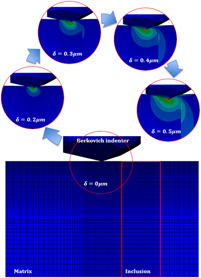Article contents
Finite element modeling of nanoindentation response of elastic fiber-matrix composites
Published online by Cambridge University Press: 26 July 2018
Abstract

A thorough investigation of nanoindentation response of fiber/matrix composites by using a Berkovich indenter and its equivalent conical counterpart was carried out. Three-dimensional finite element models were developed to study how fiber orientations and the axial distance between the fiber and nanoindenter affect the nanoindentation response of fiber/matrix composites. This demonstrates that the indenter geometry and its orientation have little effect on the nanoindentation response when the fiber is horizontally aligned to the surface. However, when the fiber is vertically embedded in the matrix, the apparent modulus measured by using the Berkovich indenter (depending on the indenter orientation) can be significantly different from its conical counterpart. The results demonstrate that when the ratio of fiber-to-indenter distance over fiber diameter is relatively small, nanoindentation response strongly depends on fiber orientation and distance between fiber and indenter as well as indenter geometry.
Keywords
- Type
- Article
- Information
- Copyright
- Copyright © Materials Research Society 2018
References
REFERENCES
- 9
- Cited by


